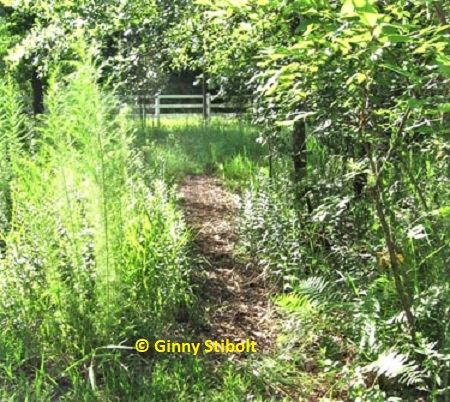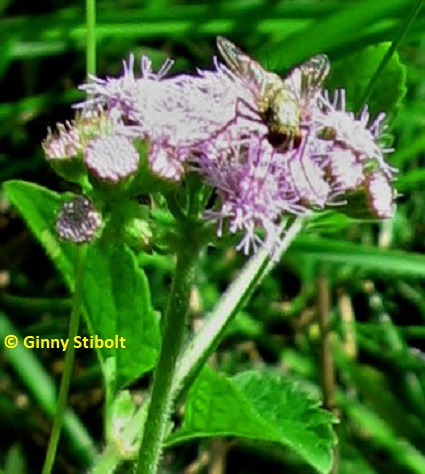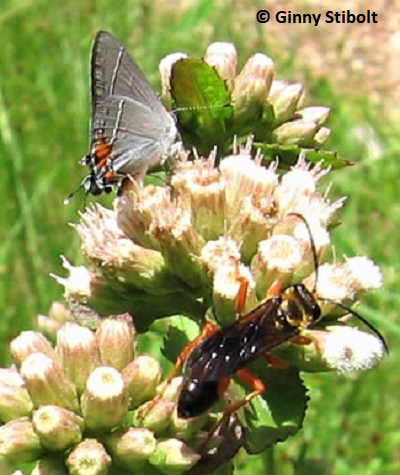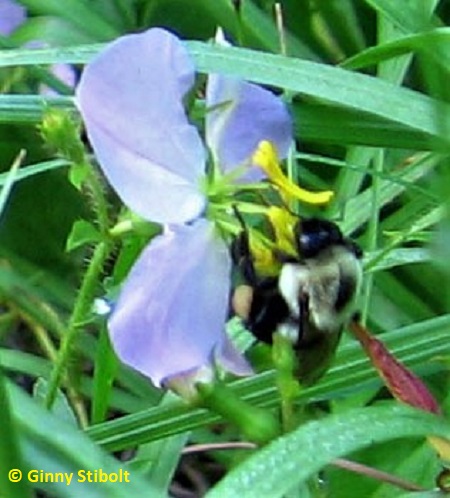Adventures of a Transplanted Gardener |
||||
Managing a natural meadow
| ||||
|
|
In order to maintain this area as a meadow, we needed to remove the trees and shrubs before they grew too large. If we'd left them there, this area would have started its natural succession to become a pine-dominated forest for a few decades. Later, oaks would become predominate. The oak forest is the climax state or ultimate sustainable condition for this area. When this occurs, the plant community will be stable and not tend to be replaced by another group of plants unless fire or man alters the environment.
Sustainable gardening practices
So for a year and a half, we spent time on other projects while Mother Nature worked on the meadow. Now after just those few hours of maintenance pulling out the trees and putting in the path, we're done for another year. Compare that to the time, effort, energy, and money we've saved by creating a meadow here instead of trying to force a lawn to grow.
Creating meadow areas is one of the sustainable gardening practices on National Wildlife Federation's list to certify your backyard as habitat. (www.nwf.org)
 |
Doesn't this early morning photo of the meadow path invite you to take a stroll? Most days I enjoy the looping path several times—the meadow hosts different critters at various times during the day. We also chase neighbors’ cats from our property and I've piled sticks in areas that they've used as their sandbox. I don’t want these subsidized predators catching the wildlife we’ve worked so hard to attract. (Keeping your cats indoors is another sustainable garden practice on NWF’s list.)
I also extended the path so there's now a complete circuit going along the edge of the pond and cutting over closer to the front fence and back to our mowed area. To create a path, I dug out a few bunches of tough grasses, covered it with the hay and plants I'd chopped down from the meadow trimming, tromped that down, and then topped the whole path with pine needles. The path is wide enough for a wheelbarrow, but not wide enough for two people.
I think paths are important when designing a meadow or other garden area to provide easy access for the caretaker(s) and for the wildlife watchers. I've taken many photos of birds, butterflies and flowers with their pollinators, but no matter how many I take, they don't begin to represent the buzzing busyness of our meadows.
 |
<< Bees and butterflies are not the only pollinators. This fly visits the flower head of a blue mistflower (Conoclinium coelestinum), a Florida native. (For some reason mist flowers and ageratum flowers don't photograph as true blue in the sun. Maybe they emit an odd wavelength of color to attract the flies--it's called the ageratum effect...)
I have removed some exotic or invasive plants so the natives have a better chance to survive and so their seeds, berries, and leaves may provide better habitat for our native birds, butterflies, and other critters.
You may also plant wildflowers in your meadows, but that's another column. We've been entertained by the flora and fauna in our marvelous natural meadow in all its seasons. When can you say that about a manicured lawn, unless there are golfers upon it?
(Update: After maintaining this area as a meadow for a number of years, we stopped removing the new trees and it has become a wooded area. I wrote "From lawn to woods: a retrospective.")
Resources:
- If you're interested in learning about native plants,
join the Florida Native Plant Society: www.fnps.org
for general information.
- This article details the certification
of our yard.
- This article covers what we've done to reduce and better manage our
mowed areas: less lawn.
Ginny Stibolt is a life-long gardener, a botanist, a naturalist, and a garden writer. You may contact her or read more of her articles posted on her website: www.greengardeningmatters.com.
Copyright Ginny Stibolt



